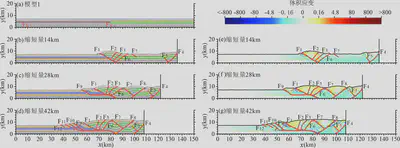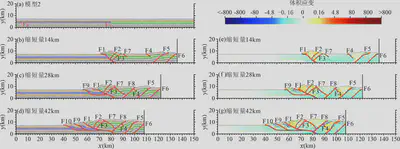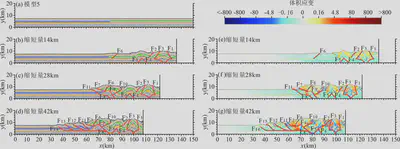Tectonic Characteristics and Evolution of the Qiyueshan Fault in the Xuefengshan Foreland Fold-and-Thrust Belt Insights from Discrete Element Numerical Simulations (Geoscience)
Title
Tectonic Characteristics and Evolution of the Qiyueshan Fault in the Xuefengshan Foreland Fold-and-Thrust Belt: Insights from Discrete Element Numerical Simulations
Author
Wang shuaijie1,2, Yan danping1,2, Zhou zhicheng1,2, Kong fei1, 2, Jing hanyang1,2, Liao wei1,2
- School of Earth Sciences and Resources, China University of Geosciences (Beijing)
- Key Laboratory of Intraplate Volcanoes and Earthquakes, China University of Geosciences (Beijing)
Abstract
The NE-trending Qiyueshan Fault divides the Xuefengshan foreland fold-and-thrust belt into the northwestern Eastern Sichuan fold-and-thrust belt and the southeastern Western Hunan fold-and-thrust belt. However, the nature and formation process of the Qiyueshan Fault remain debated, resulting in significant discrepancies in understanding the formation and evolution mechanisms of the Xuefengshan foreland fold-and-thrust belt. To investigate the formation of the Qiyueshan Fault and its control on differential deformation on both sides, seismic reflection profiles were interpreted, and five discrete element numerical simulation models were designed for experimental analysis. The results reveal that pre-existing faults localize deformation and influence the sequence of fault generation. In contrast, without pre-existing faults, deformation predominantly propagates along the lower detachment layer under weak cohesion. When the thickness of the middle detachment layer exceeds that of the lower detachment layer, deformation is governed by the middle detachment layer, leading to partial decoupling of the competent layers above and below it. Based on a comparison with seismic reflection profiles, the Xuefengshan foreland fold-and-thrust belt is characterized as a “double-step fault-bend fold system.” The Qiyueshan Fault formed during progressive deformation of the foreland belt, and the structural differences across the fault are primarily controlled by the distribution of the basal detachment layer and the mechanical properties of the Cambrian detachment layer. The Western Hunan fold-and-thrust belt is governed by deep-seated fault-bend folding, while the Eastern Sichuan fold-and-thrust belt is controlled by shallow fault-bend folding.

Fig.5 Progressive evolution of model 1(a) in shortening 14 km(b), 28 km(c), 42 km(d) and the corresponding volumetric strain ((e)-(g))

Fig.6 Progressive evolution of model 2 (a) in shortening 14 km(b), 28 km(c), 42 km(d) and the corresponding volumetric strain ((e)-(g))

Fig.7 Progressive evolution of model 3(a) in shortening 14 km (b), 28 km (c) and 42 km (d), and the corresponding volumetric strain ((e)-(g))

Fig.8 Progressive evolution of model 4(a) in shortening 14 km(b), 28 km(c), 42 km(d) and the corresponding volumetric strain ((e)-(g))

Fig.9 Progressive evolution of model 5(a) in shortening 14 km(b), 28 km(c), 42 km(d) and the corresponding volumetric strain ((e)-(g))
Conclusion
Based on five sets of discrete element numerical simulation experiments, the results indicate that the deformation on both sides of the Xuefengshan foreland fold-thrust belt and the Qiyueshan fault is primarily controlled by the distribution and mechanical properties of the basement detachment layer and the Cambrian detachment layer. The comprehensive analysis suggests:
-
When multiple sets of detachment layers exist and the cohesive strength is relatively low, stress is primarily transmitted along the lower detachment layer.
-
When the intermediate weak detachment layer is thicker than the lower one, deformation is dominated by the intermediate detachment layer, with slight decoupling occurring in the competent layer between the two. Faults generated by the basement detachment layer may become deflected.
-
The Qiyueshan fault was formed during progressive deformation. The deformation differences on both sides of the fault are mainly governed by the distribution of the basement detachment layer and the mechanical properties of the Cambrian detachment layer. The Silurian and Triassic detachment layers play a secondary, regulating role, which explains the limited exposure of breakthrough structures at the surface.
-
The Xuefengshan foreland fold-thrust belt exhibits a dual-layer, stepwise fault-bend fold structure characterized by “fault-flat–fault-ramp–fault-flat–fault-ramp.” The eastern Sichuan fold-thrust belt represents a shallow fault-bend fold zone, while the western Hunan fold-thrust belt represents a deeper one. The Qiyueshan fault, rather than being a pre-existing fault, formed as a connecting structure during progressive deformation between the two zones.
Acknowledgments
We sincerely thank the anonymous reviewers for their valuable comments and suggestions, and we are grateful to the editorial staff for their assistance and understanding during the manuscript processing. The numerical simulation experiments were conducted using the discrete element modeling software ZDEM (https://geovbox.com), developed by Dr. Changsheng Li. We also acknowledge Julia Morgan for providing the stress-strain processing scripts, which were referenced in this study.